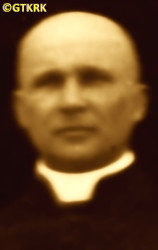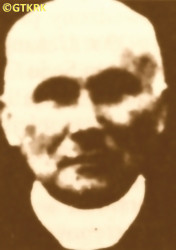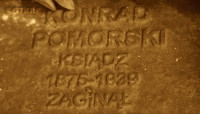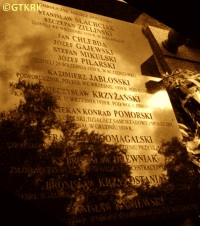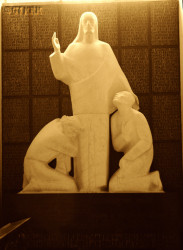Roman Catholic
St Sigismund parish
05-507 Słomczyn
85 Wiślana Str.
Konstancin deanery
Warsaw archdiocese, Poland
full list:
displayClick to display full list

searchClick to search full list by categories
wyświetlKliknij by wyświetlić pełną listę po polsku

szukajKliknij by przeszukać listę wg kategorii po polsku

Martyrology of the clergy — Poland
XX century (1914 – 1989)
personal data
surname
POMORSKI
forename(s)
Conrad (pl. Konrad)
forename(s)
versions/aliases
Clement (pl. Klemens)
function
diocesan priest
creed
Latin (Roman Catholic) Church RCmore on
en.wikipedia.org
[access: 2014.09.21]
diocese / province
Gniezno and Poznań archdiocese (aeque principaliter)more on
www.archpoznan.pl
[access: 2012.11.23]
RC Military Ordinariate of Polandmore on
en.wikipedia.org
[access: 2014.12.20]
date and place
of death
06.12.1939

n. Rogoźnotoday: Rogoźno gm., Oborniki pov., Greater Poland voiv., Poland
more on
en.wikipedia.org
[access: 2021.07.18]
alt. dates and places
of death
08.12.1939
details of death
Member of the Polish Electoral Committees in the Germ. Kreis Posen‐Ost (Eng. Poznań‐East County), and later in the Germ. Kreis Obornik (Eng. Oborniki County), part of the Prussian part of partitioned Poland, i.e. Germ. Provinz Posen (Eng. Poznań Province) in the German Empire, supporting Polish candidates to the Germ. Preußischer Landtag (Eng. Prussian National Parliament) — elections were held in 1908 and 1913 — and to the Germ. Reichstag (Eng. Reich Parliament) of the German Empire — elections were held in 1907 and 1912.
Stood up for the Poles.
In Rogoźno, where ministered — then located in the Germ. Kreis Obornik — was the patron of the „Falcon” Gymnastic Society.
There, taught also Polish language and history in the clandestine Self–Education Society.
At the end of World War I, on 21.10.1918, took part — as a representative of Rogoźno — in a conspiratorial meeting, organized at the People's Bank in Oborniki. An illegal District Citizens' Committee was founded there, modeled on the Inter–Party Committee — established in 1916, cooperating with the Polish National Committee operating in Paris since 1917, which recognized the legal authorities of Poland, supporting the Entente states in the war with the Central Powers (Germany, Austria–Hungary), but striving for a peaceful takeover of the Prussian partition lands by the future Polish state.
After the abdication on 09.11.1918 of the German Emperor William II Hohenzollern; after the signing on 11.11.1918 by the Allies and the Germans, in a staff wagon in Compiègne, at the headquarters of French Marshal Ferdinand Foch, of an armistice and ceasefire — which de facto meant the end of World War I; and also after the transfer on 11.11.1918 by the Regency Council — operating in the so‐called Germ. Königreich Polen (Eng. Polish Kingdom), the territory occupied by the Central Powers (Germany and Austria–Hungary) — of supreme military authority to Brigadier Joseph Piłsudski and appointing him Commander‐in‐Chief of the Polish Army, which de facto meant the rebirth of the Polish state, however, covering only the Germ. Königreich Polen, i.e. the Polish territory under Russian rule until 1915, but excluding the lands of the Prussian partition, which were still formally part of the German state; on 15.11.1918, chaired a meeting at the Central Hotel in Rogoźno, at which the city's Workers' and Soldiers' Council RRŻ, consisting of 15 members, was established. According to some sources, was its member. According to others, was a member of the local Citizens' Committee, transformed after coming into open into the People's Council RL. This dual system of power — RRŻ and RL — resulted from different sources of inspiration: RRŻ followed the path set by such a council established in the rebellious Berlin, while the clandestine Inter–Party Committee was at the roots of the RL. RRŻ established the City Guard and Security Service (Peoples Guard). At the same time, an organization of an armed nature was prob. established — in secret (in sources referred to as the Polish Secret Armed Organization), preparing for the inevitable, according to it, armed actions. According to some sources, was supposed to be its member.
Formally, however, Greater Poland — as the Germ. Province of Posen — still was part of the German state. On 26.12.1918, a train from Gdańsk passed through Rogoźno, with the famous pianist, Ignatius Paderewski, a passenger on board, who after many years abroad was heading towards Poznań, and then to Warsaw — to free Poland. At the railway station, the Germans attempted to stop the train, but the Rogoźno railway workers — with the support of the Allied officers accompanying Paderewski — opened a semaphore and the train continued its journey. The next day, 27.12.1918, Paderewski gave a speech in Poznań and the Greater Poland Uprising began. The Uprising broke out in Rogoźno on 31.12.1918. 01.01.1919, on New Year's Day, Polish insurgents took over the town hall, post office, and railway station. Polish flags were hung on the buildings.
After the German invasion of Poland in 09.1939 and the beginning of World War II, after the start of the German occupation, arrested on 08.09.1939 by the Germans as a hostage, probably under threat of „death, in the event of Polish resistance to soldiers of the German Wehrmacht”. The Germans occupied Rogoźno the day before, 07.09.1939.
Held in custody in Rogoźno.
Released.
Evicted from the rectory, converted into the headquarters of the Germ. Geheime Staatspolizei (Eng. Secret State Police), i.e. Gestapo.
Settled in the vicars' quarters.
Finally arrested by two Germans, dressed in civilian clothes, on 06‐08.12.1939. To this day, it has not been possible to determine who they were — perhaps Gestapo agents, but it is more likely that they were members of the genocidal paramilitary formation of the Germ. Volksdeutscher Selbstschutz (Eng. Ethnic German Self‐Defense) VS, consisting of representatives of the German national minority in Poland. The decision to establish the VS on Polish lands occupied by German troops was made in Berlin on 08‐10.09.1939 at a conference headed by Reichsführer‐SS Heinrich Himmler (call order of 20.09.1939), and the chaotically formed units were directly subordinated to officers of the genocidal SS organization.
Taken out in an unknown direction and prob. murdered — shot on the same day. There were then several similar incidents in Rogoźno, in which Poles fell victim to „unknown perpetrators”.
cause of death
murder
perpetrators
Germans
sites and events
«Intelligenzaktion»Click to display the description, Collective responsibility („Hostages”)Click to display the description, Ribbentrop‐MolotovClick to display the description, Pius XI's encyclicalsClick to display the description, Greater Poland UprisingClick to display the description
date and place
of birth
22.11.1875Birth certification on:
photos.szukajwarchiwach.gov.pl
[access: 2025.04.13]

Krobiatoday: Krobia gm., Gostyń pov., Greater Poland voiv., Poland
more on
en.wikipedia.org
[access: 2021.07.18]
parents
POMORSKI Joseph
🞲 1841, ? — 🕆 ?, ?

BALCEREK Marianne
🞲 1847, ? — 🕆 ?, ?
presbyter (holy orders)
ordination
25.09(11).1900

Gnieznotoday: Gniezno urban gm., Gniezno pov., Greater Poland voiv., Poland
more on
en.wikipedia.org
[access: 2021.12.18]
positions held
1927 – 1939
dean — Rogoźnotoday: Rogoźno gm., Oborniki pov., Greater Poland voiv., Poland
more on
en.wikipedia.org
[access: 2021.07.18] RC deanery
1910 – 1939
parish priest — Rogoźnotoday: Rogoźno gm., Oborniki pov., Greater Poland voiv., Poland
more on
en.wikipedia.org
[access: 2021.07.18] ⋄ St Vitus the Martyr RC parish ⋄ Rogoźnotoday: Rogoźno gm., Oborniki pov., Greater Poland voiv., Poland
more on
en.wikipedia.org
[access: 2021.07.18] RC deanery — also: c. 1929‐1939 inspector of religion classes in elementary schools for Rogoźno region Oborniki district; c. 1929‐1937 archbishop's delegate at matura exams in Teachers' Seminary, c. 1922‐1925 2nd deanery assessor, i.e. dean's assistant in the office, in particular in congregational activities; 1912–1939 chairman of the Supervisory Board of Peoples Bank in Rogoźno
1936
administrator — Parkowo and Słomowoparish name
today: Rogoźno gm., Oborniki pov., Greater Poland voiv., Poland ⋄ St Margaret the Virgin and Martyr RC parish ⋄ Rogoźnotoday: Rogoźno gm., Oborniki pov., Greater Poland voiv., Poland
more on
en.wikipedia.org
[access: 2021.07.18] RC deanery — acting („ad interim”)
1933
administrator — Margonintoday: Margonin gm., Chodzież pov., Greater Poland voiv., Poland
more on
en.wikipedia.org
[access: 2022.07.16] ⋄ St Adalbert the Bishop and Martyr RC parish ⋄ Rogoźnotoday: Rogoźno gm., Oborniki pov., Greater Poland voiv., Poland
more on
en.wikipedia.org
[access: 2021.07.18] RC deanery — acting („ad interim”)
1919 – 1925
chairman — Rogoźnotoday: Rogoźno gm., Oborniki pov., Greater Poland voiv., Poland
more on
en.wikipedia.org
[access: 2021.07.18] ⋄ City Council
1903 – 1910
administrator — Głuszynatoday: neighborhood in Poznań, Poznań pov., Greater Poland voiv., Poland
more on
en.wikipedia.org
[access: 2021.07.18] ⋄ St James the Great the Apostle RC parish ⋄ Poznańtoday: Poznań city pov., Greater Poland voiv., Poland
more on
en.wikipedia.org
[access: 2021.07.18] RC deanery
1903
administrator — Dębnotoday: Nowe Miasto nad Wartą gm., Środa Wielkopolska pov., Greater Poland voiv., Poland
more on
en.wikipedia.org
[access: 2021.07.18] ⋄ Assumption of the Blessed Virgin Mary RC parish ⋄ Nowe Miasto nad Wartątoday: Nowe Miasto nad Wartą gm., Środa Wielkopolska pov., Greater Poland voiv., Poland
more on
en.wikipedia.org
[access: 2020.11.27] RC deanery
1903
vicar — Śmigieltoday: Śmigiel gm., Kościan pov., Greater Poland voiv., Poland
more on
en.wikipedia.org
[access: 2021.07.18] ⋄ Assumption of the Blessed Virgin Mary RC parish ⋄ Śmigieltoday: Śmigiel gm., Kościan pov., Greater Poland voiv., Poland
more on
en.wikipedia.org
[access: 2021.07.18] RC deanery
1902 – 1903
vicar — Gnieznotoday: Gniezno urban gm., Gniezno pov., Greater Poland voiv., Poland
more on
en.wikipedia.org
[access: 2021.12.18] ⋄ Assumption of the Blessed Virgin Mary RC archcathedral parish ⋄ Gniezno Holy Trinitydeanery name
today: Gniezno urban gm., Gniezno pov., Greater Poland voiv., Poland
more on
en.wikipedia.org
[access: 2021.12.18] RC deanery
1900 – 1902
vicar — Gnieznotoday: Gniezno urban gm., Gniezno pov., Greater Poland voiv., Poland
more on
en.wikipedia.org
[access: 2021.12.18] ⋄ Holy Trinity RC parish (main parish) ⋄ Gniezno Holy Trinitydeanery name
today: Gniezno urban gm., Gniezno pov., Greater Poland voiv., Poland
more on
en.wikipedia.org
[access: 2021.12.18] RC deanery
1900
vicar — Wągrowiectoday: Wągrowiec urban gm., Wągrowiec pov., Greater Poland voiv., Poland
more on
en.wikipedia.org
[access: 2021.07.18] ⋄ St James the Apostle RC parish ⋄ Łeknotoday: Wągrowiec gm., Wągrowiec pov., Greater Poland voiv., Poland
more on
en.wikipedia.org
[access: 2021.07.18] RC deanery
till 1900
student — Gnieznotoday: Gniezno urban gm., Gniezno pov., Greater Poland voiv., Poland
more on
en.wikipedia.org
[access: 2021.12.18] ⋄ philosophy and theology, Archbishop's Practical Theological Seminary (Lat. Seminarium Clericorum Practicum)
from 1897
student — Poznańtoday: Poznań city pov., Greater Poland voiv., Poland
more on
en.wikipedia.org
[access: 2021.07.18] ⋄ philosophy and theology, Archbishop's Theological Seminary (Collegium Leoninum)
others related
in death
DREWNIAKClick to display biography Bronislav, WERBELClick to display biography Casimir Joseph
sites and events
descriptions
«Intelligenzaktion»: German: «Intelligenzaktion» (English: „Intelligence Action”) — a German program of extermination of the Polish elite, mainly the intelligentsia and leadership layers, carried out from the beginning of the occupation in w 09.1939 to 04.1940, mainly in territories directly annexed to Germany, but also in the so‐called Germ. Generalgouvernement (Eng. General Governorate), where it was called «AB‐aktion». In the first phase, immediately after the beginning of the German occupation, during military operations carried out by the Germ. Wehrmacht (Eng. Armed Forces) and the genocidal units of the Germ. Einsatzgruppen (Eng. Operational Groups) of the Germ. Sicherheitspolizei (Eng. Security Police), i.e. SiPo, and Germ. Sicherheitsdienst des Reichsführers SS (Eng. Security Service of the Reichsführer SS), i.e. SD, organized by the Germ. Reichssicherheitshauptamt (Eng. Reich Main Security Office), i.e. RSHA, which followed the troops, carried out under the Germ. Unternehmen „Tannenberg” (Eng. Operation „Tannenberg”) — based on the so‐called Germ. Sonderfahndungsliste (Eng. Special Wanted Lists), i.e. proscription lists of Poles considered particularly dangerous to the Third Reich, prepared by the Zentralstelle II/P (Polen) unit of the German RSHA. Later, implemented by the German civilian occupation authorities and the genocidal unit of the Germ. Volksdeutscher Selbstschutz (Eng. Ethnic Germans Self‐Defense), whose members were Germ. Volksdeutsche (Eng. Ethnic Germans), i.e. representatives of the German minority in Poland. According to various sources, these lists, at the beginning of 09.1939, could have contained the details of 61,000—88,000 „dangerous” Poles — although these figures cannot be confirmed. In total, during this genocide, c. 50,000 teachers, Catholic priests, representatives of the landed gentry, freelancers, social and political activists, and retired military personnel were systematically and methodically murdered. Another 50,000 were sent to concentration camps, where only a negligible percentage survived. (more on: en.wikipedia.orgClick to attempt to display webpage
[access: 2014.10.04])
Collective responsibility („Hostages”): A criminal practice implemented by the Germans in the occupied territories of Poland, applied from the very first day of World War II. At its core was an appointment and public announcement of a list of names of selected people whose lives depended on absolute compliance with German orders. Any violation of these ordinances, by any person, regardless of the circumstances, resulted in the murder of the designated „hostages”. In the first days of the war and occupation, it was used i.a. by the German Wehrmacht army to prevent acts of continuation of the defense by the Poles. Later, especially in the German‐run General Governorate, it was part of the official policy of the occupation authorities — collective responsibility for any acts of resistance to the occupier's practices. For the life of one German, even if death was due to customary reasons, the Germans carried out executions from a dozen to even a hundred Poles previously designated as „hostages”.
Ribbentrop‐Molotov: Genocidal Russian‐German alliance pact between Russian leader Joseph Stalin and German leader Adolf Hitler signed on 23.08.1939 in Moscow by respective foreign ministers, Mr. Vyacheslav Molotov for Russia and Joachim von Ribbentrop for Germany. The pact sanctioned and was the direct cause of joint Russian and German invasion of Poland and the outbreak of the World War II in 09.1939. In a political sense, the pact was an attempt to restore the status quo ante before 1914, with one exception, namely the „commercial” exchange of the so‐called „Kingdom of Poland”, which in 1914 was part of the Russian Empire, fore Eastern Galicia (today's western Ukraine), in 1914 belonging to the Austro‐Hungarian Empire. Galicia, including Lviv, was to be taken over by the Russians, the „Kingdom of Poland” — under the name of the General Governorate — Germany. The resultant „war was one of the greatest calamities and dramas of humanity in history, for two atheistic and anti‐Christian ideologies — national and international socialism — rejected God and His fifth Decalogue commandment: Thou shall not kill!” (Abp Stanislav Gądecki, 01.09.2019). The decisions taken — backed up by the betrayal of the formal allies of Poland, France and Germany, which on 12.09.1939, at a joint conference in Abbeville, decided not to provide aid to attacked Poland and not to take military action against Germany (a clear breach of treaty obligations with Poland) — were on 28.09.1939 slightly altered and made more precise when a treaty on „German‐Russian boundaries and friendship” was agreed by the same murderous signatories. One of its findings was establishment of spheres of influence in Central and Eastern Europe and in consequence IV partition of Poland. In one of its secret annexes agreed, that: „the Signatories will not tolerate on its respective territories any Polish propaganda that affects the territory of the other Side. On their respective territories they will suppress all such propaganda and inform each other of the measures taken to accomplish it”. The agreements resulted in a series of meeting between two genocidal organization representing both sides — German Gestapo and Russian NKVD when coordination of efforts to exterminate Polish intelligentsia and Polish leading classes (in Germany called «Intelligenzaktion», in Russia took the form of Katyń massacres) where discussed. Resulted in deaths of hundreds of thousands of Polish intelligentsia, including thousands of priests presented here, and tens of millions of ordinary people,. The results of this Russian‐German pact lasted till 1989 and are still in evidence even today. (more on: en.wikipedia.orgClick to attempt to display webpage
[access: 2015.09.30])
Pius XI's encyclicals: Facing the creation of two totalitarian systems in Europe, which seemed to compete with each other, though there were more similarities than contradictions between them, Pope Pius XI issued in 03.1937 (within 5 days) two encyclicals. In the „Mit brennender Sorge” (Eng. „With Burning Concern”) published on 14.03.1938, condemned the national socialism prevailing in Germany. The Pope wrote: „Whoever, following the old Germanic‐pre‐Christian beliefs, puts various impersonal fate in the place of a personal God, denies the wisdom of God and Providence […], whoever exalts earthly values: race or nation, or state, or state system, representatives of state power or other fundamental values of human society, […] and makes them the highest standard of all values, including religious ones, and idolizes them, this one […] is far from true faith in God and from a worldview corresponding to such faith”. On 19.03.1937, published „Divini Redemptoris” (Eng. „Divine Redeemer”), in which criticized Russian communism, dialectical materialism and the class struggle theory. The Pope wrote: „Communism deprives man of freedom, and therefore the spiritual basis of all life norms. It deprives the human person of all his dignity and any moral support with which he could resist the onslaught of blind passions […] This is the new gospel that Bolshevik and godless communism preaches as a message of salvation and redemption of humanity”… Pius XI demanded that the established human law be subjected to the natural law of God , recommended the implementation of the ideal of a Christian state and society, and called on Catholics to resist. Two years later, National Socialist Germany and Communist Russia came together and started World War II. (more on: www.vatican.vaClick to attempt to display webpage
[access: 2023.05.28], www.vatican.vaClick to attempt to display webpage
[access: 2023.05.28])
Greater Poland Uprising: Military insurrection of Poles of former German Germ. Posen Provinz (Eng. Poznań province) launched against German Reich in 1918‐1919 — after the abdication on 09.11.1918 of the German Emperor William II Hohenzollern; after the armistice between the Allies and Germany signed on 11.1.1918 in the HQ wagon in Compiègne, the headquarters of Marshal of France Ferdinand Foch — which de facto meant the end of World War I — against the German Weimar Republic, established on the ruins of the German Empire, aiming to incorporate lands captured by Prussia during partitions of Poland in XVIII century into Poland. The Republic of Poland, reborn on 11.11.1918, initially formally included only the so‐called Germ. Königreich Polen (Eng. Kingdom of Poland), i.e. the territory that had been under Russian rule until 1915 and then under the control of Central States (Germany and Austria–Hungary), but did not include the Prussian partition. Started on 27.12.1918 in Poznań and ended on 16.02.1919 with the armistice pact in Trier, forced by the victorious Entente states, which included provisions ordering Germany to cease operations against Poland and, importantly, recognizing the Polish insurgent Greater Poland Army as an allied armed force of the Entente. De facto it turned out to be a Polish victory, confirmed in the main peace treaty after World War I, the Treaty of Versailles of 28.06.1919, which came into force on 10.01.1920 and in which most of the lands of the Prussian partition were recognized as Polish. Many Polish priests took part in the Uprising, both as chaplains of the insurgents units and members and leaders of the Polish agencies and councils set up in the areas covered by the Uprising. In 1939 after German invasion of Poland and start of the World War II those priests were particularly persecuted by the Germans and majority of them were murdered. (more on: en.wikipedia.orgClick to attempt to display webpage
[access: 2016.08.14])
sources
personal:
www.muzeum.gostyn.plClick to attempt to display webpage
[access: 2012.11.23], www.filipini.poznan.plClick to attempt to display webpage
[access: 2012.11.23], photos.szukajwarchiwach.gov.plClick to attempt to display webpage
[access: 2025.04.13]
bibliographical:
„Social Activist Priests in Greater Poland”, collective work, Biographical Dictionary, vol. 3 P‐S, Gniezno 2008
original images:
audiovis.nac.gov.plClick to attempt to display webpage
[access: 2016.08.14], muzeum.gostyn.plClick to attempt to display webpage
[access: 2019.05.30], s11-protest.plClick to attempt to display webpage
[access: 2024.01.05], rogozno.plClick to attempt to display webpage
[access: 2019.10.13]
LETTER to CUSTODIAN/ADMINISTRATOR
If you have an Email client on your communicator/computer — such as Mozilla Thunderbird, Windows Mail or Microsoft Outlook, described at WikipediaPatrz:
en.wikipedia.org, among others — try the link below, please:
LETTER to CUSTODIAN/ADMINISTRATORClick and try to call your own Email client
If however you do not run such a client or the above link is not active please send an email to the Custodian/Administrator using your account — in your customary email/correspondence engine — at the following address:

giving the following as the subject:
MARTYROLOGY: POMORSKI Conrad
To return to the biography press below:
 Click to return to biography
Click to return to biography








